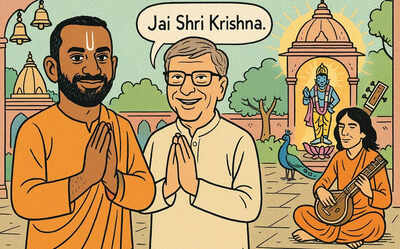It was the kind of television moment that doesn’t announce itself as historic but lingers anyway. On one side of the screen, Tulsi Virani — stalwart matriarch of Indian primetime melodrama — offered her trademark folded-hand salutation. On the other side, beamed in from across the world, Bill Gates, Microsoft co-founder and global philanthropist, smiled and echoed her words: “Jai Shri Krishna.”The scene, part of a guest appearance on Kyunki Saas Bhi Kabhi Bahu Thi 2, was meant to signal goodwill. Perhaps a nod to the show’s wide appeal, perhaps a gesture of cultural diplomacy. But what stood out wasn’t Gates’ presence so much as his fluency. That three-word Sanskrit phrase, offered without hesitation, felt at once surprising and entirely plausible.Just months earlier, Kash Patel — former Pentagon chief of staff and nominee for FBI Director — opened his U.S. Senate hearing by saying the same phrase. With his parents seated behind him, Patel touched their feet and addressed the room in English before adding, “Jai Shri Krishna.” No translation followed. None was needed.In both cases, the phrase didn’t come with explanation. It simply hung in the air, as if its meaning had already traveled ahead of the words themselves. The West, it seemed, had begun to understand.
Bhakti on a One-Way Ticket
The story of how Krishna’s name became recognizable in the West often begins with a voyage. In 1965, a 69-year-old monk named A.C. Bhaktivedanta Swami Prabhupada left Kolkata aboard a cargo ship bound for New York. He arrived with little money, a crate of translated scriptures, and a conviction that the message of Krishna consciousness — bhakti, or loving devotion to God — could take root in the West.At first, it was an improbable proposition. The America of the mid-sixties was culturally unsettled: urban unrest, civil rights uprisings, Vietnam protests. But it was also a place of spiritual restlessness. When Prabhupada began leading public chants in Tompkins Square Park and holding lectures in a small East Village storefront, curious young Americans — some disillusioned, others simply curious — began to gather.He founded the International Society for Krishna Consciousness (ISKCON) in 1966. What followed was not mass conversion, but a kind of absorption. The movement aligned itself with the counterculture without fully surrendering to it. Western followers shaved their heads, wore saffron robes, and greeted strangers with “Hare Krishna.” It was a movement defined by music, repetition, and a quiet certainty that joy — both spiritual and communal — could be revolutionary.
George Harrison’s Gift
No cultural movement cements itself in Western consciousness without help from the mainstream. In ISKCON’s case, it arrived in the form of a Beatle.George Harrison, already drawn to Indian music and philosophy, became one of the movement’s most visible patrons. He helped finance the first ISKCON temple in London and produced a recording of the Hare Krishna mantra that became a minor hit on British radio. Later, his own single My Sweet Lord blended gospel with Sanskrit chants, bringing Krishna’s name to the top of charts in Europe and the United States.Harrison also donated Bhaktivedanta Manor, an estate outside London that remains a major ISKCON center to this day. And it was through him that many first encountered Krishna, not through scripture or theology, but through melody. The mantras didn’t require belief to be sung. And in the singing, something shifted.Still, the movement remained, in the public eye, a curiosity. Saffron-robed devotees danced at airports and offered free food on college campuses. Krishna’s name was heard more often in pop culture. Yet through it all, the phrase “Jai Shri Krishna” lingered quietly, spoken less in public but rooted in private homes and temples. The groundwork for its future visibility was being laid.
Institution Becomes Infrastructure
By the 1980s, the energy of the early movement had settled. ISKCON faced the challenges common to many religious institutions: leadership changes, internal scrutiny, and the slow departure of public novelty. But even as the headlines faded, the work continued. Temples were built. Farms were run. Food relief programs served communities across continents.Meanwhile, the Indian diaspora grew — and with it, a different kind of devotional visibility. Second-generation Indian Americans and British Indians began to assert their identities with less hesitation. “Jai Shri Krishna” was heard at weddings, community events, and holiday celebrations. It became part of the rhythm of diasporic life.This wasn’t the spectacle of street chanting. It was quieter, embedded in the everyday. Krishna moved from public parks to suburban homes, and his name became part of the domestic soundtrack. A grandmother’s greeting, a text message sign-off, a child’s temple recital. The phrase traveled, not through institutions, but through memory.
Secular Fluency and Diaspora Confidence
By the early 2000s, Krishna was no longer unfamiliar. Yoga studios ended sessions with Sanskrit chants. Mindfulness apps included Gita verses. Pop music sampled mantras. The vocabulary of Indian spirituality had entered the global mainstream — often simplified, but rarely mocked.At the same time, the political visibility of the Indian diaspora began to rise. Leaders like Rishi Sunak, Kamala Harris, and Tulsi Gabbard represented different ideological strands but carried with them a certain cultural texture. Diwali was now celebrated at Downing Street and the White House. Bhagavad Gita verses were cited in American legislative debates. Public rituals were no longer hidden. They were staged.In this context, the casual appearance of “Jai Shri Krishna” — whether from a tech mogul or a political nominee — no longer seemed novel. Gates’ invocation may have been scripted, but it landed because it was legible. Patel’s salutation may have been personal, but it didn’t need explaining. The phrase had become part of the public grammar of diaspora belonging.
Not Just a Salutation
“Jai Shri Krishna” is more than a greeting. It’s a gesture, a signal, and a tiny piece of liturgy. It names a god, certainly, but also names a tradition — one of playfulness, wisdom, and intimacy with the divine. It’s the sort of phrase that doesn’t need to convince in order to resonate.Unlike doctrinal declarations, it asks nothing in return. It can be spoken out of belief, habit, pride, or affection. And it travels well. Between elders and children. Between friends across time zones. Between strangers who recognize the cadence before they understand the words.Its entry into public life didn’t happen because someone planned it. It happened because people carried it — sometimes consciously, sometimes not.
From Devotional Murmur to Cultural Echo
The phrase “Jai Shri Krishna” did not arrive in the West with Gates or Patel. Nor did it spread solely through the momentum of one movement or one community. Its path has been uneven, shaped by accident as much as intention. Partly through the songs of a Beatle. Partly through the teachings of a monk. Partly through the Sunday school recitals of suburban temples. And partly through the persistence of memory among those who migrated but did not forget.Its current recognizability owes less to any concerted effort than to decades of quiet repetition. Ritual became routine. What was once whispered in courtyards now occasionally appears in the public record. These appearances should not be overstated. A tech billionaire repeating a Sanskrit phrase or a Senate nominee invoking Krishna does not mark a religious transformation. It signals something subtler — that Krishna’s name no longer startles, that his presence in public language no longer requires justification. The West has not adopted Krishna. But it has learned, slowly, to share space with him. In the long history of religious expression, that alone marks a shift worth noticing. Go to Source




